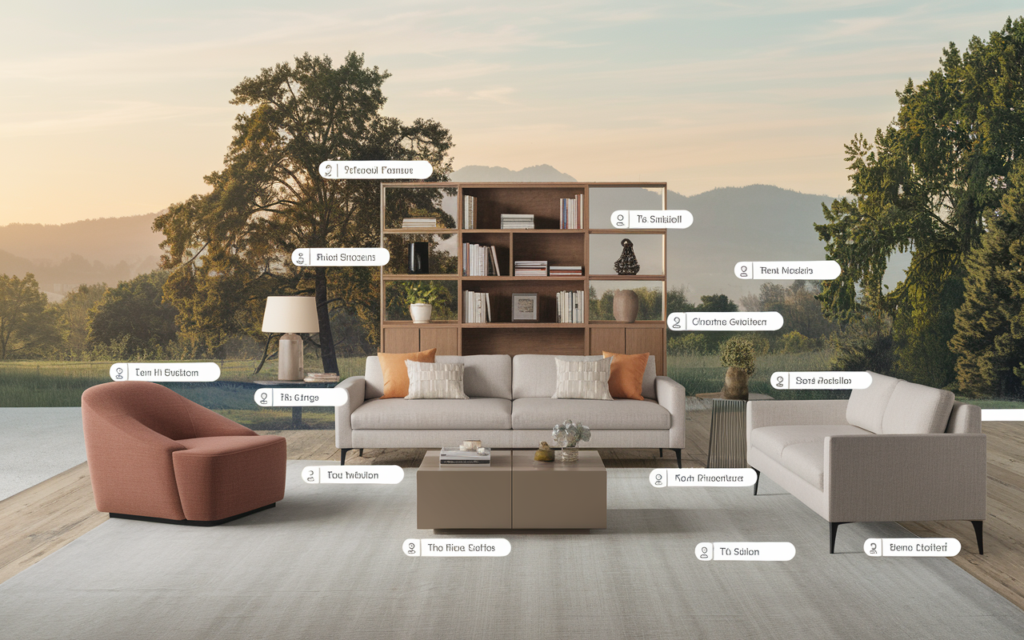Revolutionizing Interiors: How AI, VR, and AR Are Shaping the Future of Furnishings

The interior design and furnishings industry is undergoing a transformation with the integration of cutting-edge technologies like Artificial Intelligence (AI), Virtual Reality (VR), and Augmented Reality (AR). These tools are changing the way we design, visualize, and experience spaces—offering immersive, personalized, and efficient solutions for both businesses and customers.
Why AR and VR Matter in the Furnishings Industry
Augmented Reality (AR) overlays digital content onto the physical world, enabling customers to visualize furniture in their own spaces before purchase. Virtual Reality (VR) immerses users in a fully digital environment, offering life-like simulations of spaces and layouts. Combined with AI, these technologies elevate the customer experience by enhancing realism, customization, and interactivity.
Key Applications and Benefits
1. Room Visualization and Design
AR tools empower customers to virtually place furniture in their homes, helping them visualize scale, fit, and aesthetics.
- Example: Arhaus’s Room Planner allows shoppers to customize layouts and test various furnishings in virtual room setups.
- Impact: Boosts purchasing confidence and lowers return rates by allowing customers to “try before they buy.”
2. Hyper-Personalization
AI-driven AR applications enable:
- Experimentation with colors, finishes, and layouts.
- Emotion-based customization, where virtual environments adapt to user preferences.
- Enhanced visualization of custom furniture options.
- Example: Ethan Allen’s app lets users tailor furniture and visualize it in their spaces before making decisions.
3. Immersive Showrooms
Luxury brands are turning to VR to create virtual showrooms that bridge the gap between online and in-person shopping.
- Example: Poltrona Frau offers virtual environments where clients can explore collections in hyper-realistic settings.
4. Marketing and Engagement
AR features like QR codes on brochures or business cards allow customers to pull up 3D models of products and view them in their homes.
- Example: SCANLIVING uses QR codes to create interactive product catalogs with AR-enabled visualization.
5. Assembly Assistance
Furniture brands are exploring AR-guided assembly instructions to simplify setup for customers.
- Example: Apps like Assemble AR showcase how brands can provide next-level support through interactive instructions.
Transforming the Design Process
AI, VR, and AR are not just for customer-facing applications—they’re transforming back-end processes as well:
- Prototyping: VR allows designers to create and refine virtual models, reducing reliance on costly physical samples.
- Sustainability: Minimizing material waste by perfecting designs virtually.
- Collaboration: Global teams can co-create in shared virtual environments, streamlining communication and decision-making.
Benefits for Furniture Retailers
- Increased Sales: Research shows AR boosts purchase likelihood by 65% and increases order volumes by 27%.
- Fewer Returns: AR reduces the need for returns by helping customers make more informed decisions.
- Enhanced Customer Engagement: AR tools increase browsing time and foster stronger connections with products.
The Road Ahead
As AI continues to evolve, the integration of AR and VR will open even more possibilities:
- Sustainability Insights: Simulate eco-friendly production methods.
- AI-Powered Design: Automatically generate furniture layouts based on customer preferences.
- Global Reach: Use virtual tools to connect international designers, manufacturers, and clients.
Elevate Your Business with AR and VR Whether you’re a furniture brand, designer, or retailer, adopting AR, VR, and AI is no longer optional—it’s essential. These technologies are revolutionizing how customers interact with furnishings and spaces, offering a seamless blend of innovation, elegance, and functionality.
The interior design and furnishings industry is undergoing a revolutionary shift with the integration of Artificial Intelligence (AI), Virtual Reality (VR), and Augmented Reality (AR). These technologies are enhancing realism, personalization, and functionality, offering transformative tools for designers, brands, and clients alike. Here’s how these innovations are shaping the future of interiors:
Immersive Showrooms: Redefining Customer Experiences
Virtual showrooms powered by VR are becoming the new standard for showcasing furnishings. Luxury brands like Poltrona Frau and Natuzzi Italia enable clients to explore collections in hyper-realistic virtual environments tailored to their preferences.
Lighting brands such as FLOS use VR to demonstrate how fixtures interact with light and shadow, helping customers envision the atmosphere their products create. These immersive experiences remove geographical barriers and allow clients to assess scale, proportion, and style more effectively than traditional methods.
AI-Powered Personalization in Furnishings
Personalization is at the heart of interior design, and AI is making it more accessible and precise. By analyzing user data, AI enables clients to:
- Experiment with materials, colors, and finishes in real-time.
- Visualize furniture and decor placement in their actual spaces through AR.
- Customize furnishings to meet their exact specifications.
For example, tools like Fologram allow designers and homeowners to place furniture in virtual layouts using AR, while brands like Minotti offer VR applications for tailoring sofas and layouts.
Streamlined Design and Prototyping
AI and VR are revolutionizing the design and manufacturing processes for furnishings:
- Prototyping in VR: Designers can create virtual models, minimizing the need for costly physical prototypes and accelerating product development.
- Sustainability: By reducing material waste, virtual prototyping supports environmentally friendly practices.
- Collaborative Design: Clients and designers can co-create furniture or layouts in virtual environments, ensuring precise alignment with client visions.
Luxury brands like Roche Bobois are leading the way, leveraging VR for real-time client collaboration during the design process.
AI-Generated Content for Interiors
AI extends its capabilities beyond enhancement into content creation:
- 3D Models and Environments: AI generates realistic furniture models and virtual spaces tailored to client preferences.
- Dynamic Furniture Placement: Apps like Fologram let users experiment with furniture arrangements, offering an intuitive design experience.
Virtual Storytelling: Highlighting Craftsmanship
VR is not just a design tool—it’s a storytelling medium. Brands can use VR to take clients on virtual tours of workshops, showcasing the craftsmanship behind bespoke furniture or handcrafted decor. For instance, a VR experience might reveal the intricate process of designing a custom chandelier or assembling a luxury sofa.
This storytelling fosters a deeper appreciation for the artistry and heritage behind each piece, elevating the perceived value of the product.
Future Trends in Interior Design Technology
As AI, VR, and AR continue to evolve, their impact on the furnishings industry will expand. Key future developments include:
- Sustainable Design Showcases: Simulating eco-friendly production processes to align with customer values.
- Global Collaboration: Enabling designers, architects, and clients to collaborate seamlessly in virtual spaces.
- Hyper-Personalization: Using AI to create dynamically adaptive furnishings and interiors that respond to individual needs and behaviors.
Bridging Elegance and Technology
For the interior design and furnishings industry, the integration of AI, VR, and AR is not just a trend—it’s the future. These technologies empower designers to innovate, brands to engage clients more effectively, and customers to make informed, personalized choices. By embracing this digital transformation, the industry is poised to create interiors that are as intelligent and functional as they are beautiful.


Leave a Reply